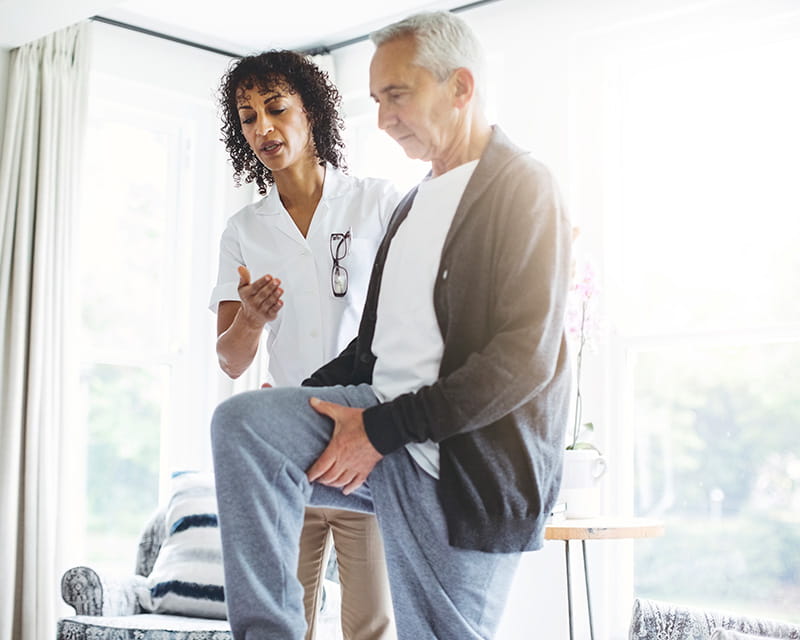
Multidisciplinary Clinic Aims to Reduce Fall-Related Injuries and Deaths
 A years-long effort to reduce time to surgery for hip fracture patients is leading to better long-term outcomes
A years-long effort to reduce time to surgery for hip fracture patients is leading to better long-term outcomesFast surgical treatment is critical to lowering mortality rates associated with hip fracture, especially among older adults. Current national guidelines recommend surgery within 48 hours of fracture, but doctors at The Ohio State University Wexner Medical Center are working to cut that time in half for their patients.
Carmen Quatman, MD, PhD, and Laura Phieffer, MD, both with Ohio State’s Department of Orthopaedic Surgery, have championed an effort through their fragility fracture protocol that’s already reduced average time to surgery (TTS) to 30 hours.
They have worked with a multidisciplinary team to sustain or beat that metric for years now due to a paradigm shift — one that prioritizes hip fractures and puts them on par with other life-threatening emergencies.
Their work has led the medical center to receive premier-level certification among Geriatric Fracture Care Programs from the International Geriatric Fracture Society (IGFS).
Quatman and Phieffer say education all along the care spectrum has been critical to their institutional success.
“We began this quality improvement journey more than a decade ago,” Phieffer says. “The literature was showing that the sooner a patient got to surgery, the better their outcomes.”
And they’ve helped develop the data, too, through participation in the international HIP ATTACK study and their own studies of surgical timing, complications and post-surgical mobility.
Armed with evidence, the two physicians began sharing what they know about hip fracture and TTS.
“We know that early mobility is crucial for these patients,” Phieffer says. “We had to make it clear to everyone along the care continuum that just because a hip fracture may be considered a low-energy fall, that doesn’t mean it’s a low-priority issue for the patient.”
Their education efforts paid off. Hip surgery cases that years ago were treated as “add ons” are now viewed as priority.
More specifically, the team was able to secure standing operating room time and move cases as necessary to treat hip fracture with more urgency.
“We’ve been able to do something that many systems still struggle with from a resource perspective” Quatman says. “And by prioritizing hip fracture surgery so we can get these patients moving again, we’ve also reduced medical complications that can pose major challenges to recovery, like blood clots, bed sores and pneumonia.”
Another important part in improving TTS after a hip fracture is medical optimization.
“Many patients with hip fracture have other illnesses or conditions that could prevent them from moving quickly into surgery,” Quatman says. “They must be ‘medically optimized’ before they can get the treatment they need.”
Medical hospitalists at Ohio State meet with each hip fracture patient and work quickly to optimize their health and prepare them for surgery.
“This work starts the minute someone shows up to our hospital,” Quatman says. “That’s because timeliness to surgery is so important. It’s critical to improve someone’s pain, their quality of life and ultimately their long-term outcomes.”
Quatman and Phieffer know that the surgical interventions they offer amount to just a few hours in the total continuum of a person’s care, and it’s just one element that affects long-term outcomes.
“What happened before they showed up with the hip fracture will play a huge role in what happens after,” Quatman says. “Where did they come from? What support system do they have? Did they fall in their home? All of this is important. We can’t just focus on the hospital piece — we must also see the bigger picture.”
To extend the care of hip fracture patients beyond the hospital, the surgeons partner with the medical center’s Ortho CONNECT program. Run by a physician assistant, this program provides postoperative care on-site and via telehealth for patients in skilled nursing or long-term care facilities.
“Ortho CONNECT is an extension of the hospital experience and offers patients more one-to-one care,” Quatman says. “This program and its telehealth offering has been especially critical during the COVID-19 pandemic.”
Quatman and Phieffer say partnerships like those they’ve formed with Ortho CONNECT, as well as rehabilitation, case management and nursing staff, have made all the difference in ensuring positive momentum for hip fracture patients. They emphasize that for others looking to improve hip fracture care at their own facilities, it’s all about resources, capacity and commitment to community.
“For centers with higher volumes of these patients and no place to send them to get the care they need, it’s totally worth advocating for and creating a program like this,” Phieffer says.
“There’s also a need to recognize if you have capacity, or if you need to partner with another center or system that can help you leverage your outreach to care for these patients.
“These patients in our center are not elective surgeries. They continue to have the priority. I’m so grateful for the shift we’ve seen — and led. We’ve come a long way from when I was in surgical training and in my first years of practice to where we are today.”